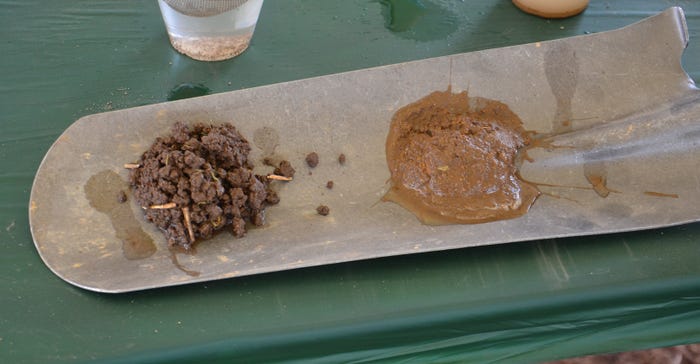
You’ve likely seen soil residue and soil structure demonstrations at field days. But you may not have seen several different types of demonstrations conducted right before your eyes in rapid fire.
Stephanie McLain and Joe Rorick aren’t magicians, yet it seemed like they were when they performed a series of simple demonstrations at the Indiana Agriculture Nutrient Alliance field day. They wanted to make sure no one left without understanding that no-till and tilled soil have different structures and offer vastly differing amounts of protection for the soil surface.
McLain, a conservation specialist with the Natural Resources Conservation Service, and Rorick, a specialist with the Conservation Cropping Systems Initiative, saved their best “trick” for last. It was actually a true demonstration, not a trick at all.
“We wanted to show differences which develop in soil structure over time in no-tilled versus conventionally tilled soil,” McLain explains. “If you take a sample of both from respective fields and let them sit in water briefly, you can show it easily.”
The pair put a no-till sample and a tilled sample in shallow cups, each with a wire basket inside. The samples rested in the baskets. Particles began sloughing off the tilled sample, while the no-till sample remained mostly intact. The real test was when McLain dumped the samples upside down onto a spade, side by side.
The no-till sample held its shape, still looking like a lump of soil. The conventionally tilled simply melted onto the spade, spreading out and maintaining virtually no structure at all.
“It’s simple to do, but it really makes the point,” McLain says. “The conventionally tilled sample doesn’t have any structure or ‘glue’ from microbes to hold it together. It spreads out into a glob on the spade. The no-till sample just sits there because it has enough structure to hold it together.”
Other tests
The pair of conservation specialists also demonstrated a simple version of a rain simulator. Samples of soil with and without cover were placed into trays. They poured water onto the surface, simulating a rainstorm. Water running off collected in containers.
This test illustrates that more water runs off tilled soils compared to no-till soils, McLain says. When it runs off, it carries soil particles with it, which accumulate in the container as sediment.
That shows how sediment ends up in streams and rivers when it is lost from fields that aren’t protected by residue, she says. It also illustrates why water can move into the soil more easily on no-till soil. Infiltration rate is higher on no-till soils, McLain explains.
Other tests on their tabletop display made similar points. No-till soil from continuous no-till fields tends to have improved soil structure, which helps it hold together and manage rain events more easily, she concludes.
See photos of these different demonstrations in the accompanying slideshow.
About the Author(s)
You May Also Like




